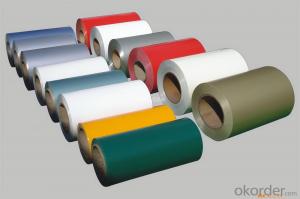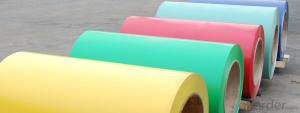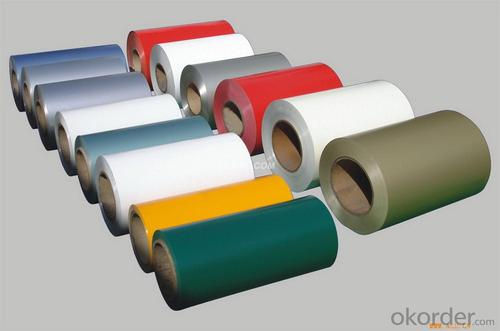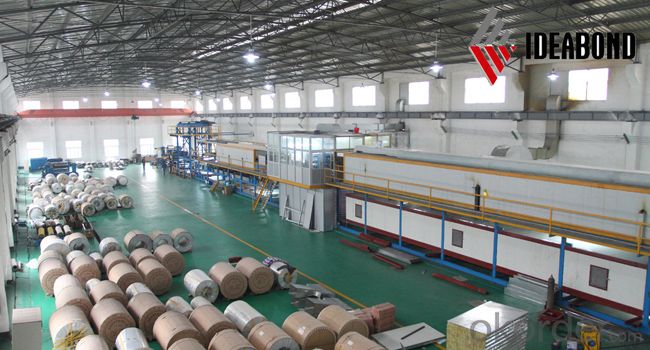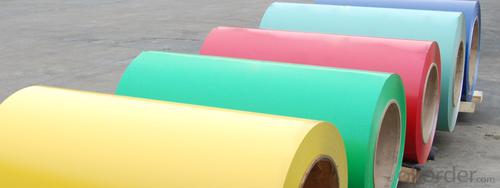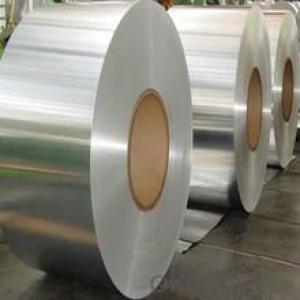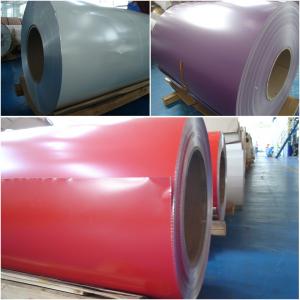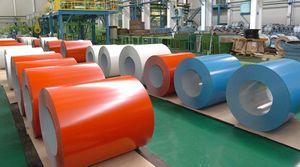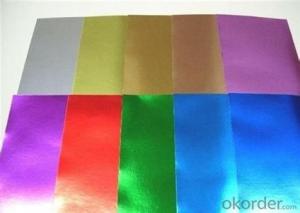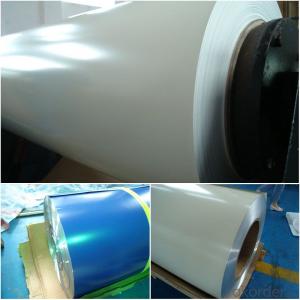Wholesale PVDF AA3105 Coated Stucco Embossed Aluminum Sheet Foil Coil
- Loading Port:
- Shanghai
- Payment Terms:
- TT OR LC
- Min Order Qty:
- 20 m.t.
- Supply Capability:
- 800000 m.t./month
OKorder Service Pledge
Quality Product, Order Online Tracking, Timely Delivery
OKorder Financial Service
Credit Rating, Credit Services, Credit Purchasing
You Might Also Like
supply Mill-finished / coated aluminum sheet/ coil:
Alloy: AA1050,1060,1100,1200,2024,3003,3304,3005,3015,5052,5086,5754,5083,6061,7050,7475,8011, etc
Temper: O, H14/16/18/22/24/32/ H112/H321/T6,T851,T7451,T7351, etc
Thickness: 0.02mm—20mm
Width: 100mm—2000mm (Can be slitted)
Notice: PE coating / PVDF coating / Embossment can be done if required.
- Q: How are aluminum coils used in the production of solar panels?
- The production of solar panels heavily relies on aluminum coils, as they perform essential functions in the construction of photovoltaic modules. These coils are primarily employed as the framing material for the PV module, offering structural support and safeguarding the delicate solar cells from external forces like weather or physical harm. Aluminum's lightweight yet robust characteristics make it an ideal choice for this purpose, as it ensures durability without burdening the overall structure with excessive weight. Additionally, aluminum coils are commonly utilized as the backsheet material in solar panels. The backsheet plays a crucial role in shielding the solar cells from moisture, dust, and other environmental elements, acting as a barrier that prevents potential damage while providing electrical insulation. Aluminum's exceptional resistance to corrosion and its electrical conductivity make it highly suitable for this application. Moreover, aluminum coils are employed in the fabrication of the interconnection system within solar panels. This system comprises conducting wires that establish connections between individual solar cells, enabling the efficient flow of electricity among them. Aluminum's high electrical conductivity ensures minimal energy losses within the panel, facilitating the effective transmission of generated electricity. Furthermore, aluminum coils find utility in the manufacturing of various other components within solar panels, including junction boxes, connectors, and mounting systems. These components contribute to the overall functionality and reliability of solar panel systems. In summary, the extensive use of aluminum coils in solar panel production can be attributed to their lightweight, durable, and corrosion-resistant properties. These coils exhibit versatility and the ability to withstand harsh environmental conditions, making them indispensable for ensuring the efficiency and longevity of solar panel systems.
- Q: What is the maximum temperature resistance of aluminum coils?
- Various factors, including alloy composition, purity, and specific application, determine the maximum temperature resistance of aluminum coils. Generally, aluminum has a low melting point of approximately 660 degrees Celsius (1220 degrees Fahrenheit). As a result, the temperature resistance of aluminum coils typically falls between 200 and 400 degrees Celsius (392 to 752 degrees Fahrenheit). Exceeding these temperatures may lead to structural alterations in aluminum, such as softening or deformation, which could affect its performance and integrity. Consequently, it is crucial to consider the specific demands and limitations of the application when determining the maximum temperature resistance of aluminum coils.
- Q: Can aluminum coils be customized in terms of thickness?
- Yes, aluminum coils can be customized in terms of thickness. The thickness of aluminum coils can be modified through various manufacturing processes to meet specific requirements and applications.
- Q: What are the fire resistance properties of aluminum coils?
- Aluminum coils have excellent fire resistance properties due to the unique characteristics of the metal. Aluminum has a high melting point of 660 degrees Celsius (1220 degrees Fahrenheit), which allows it to withstand high temperatures without deforming or melting. In addition, aluminum forms a thin layer of oxide on its surface when exposed to air, which acts as a protective barrier against fire and prevents further oxidation. This oxide layer has a high melting point and is non-combustible, making it an effective fire retardant. Furthermore, aluminum is a poor conductor of heat, meaning it does not readily transfer heat during a fire, which helps to slow down the spread of flames. Therefore, aluminum coils are widely used in various applications where fire resistance is a crucial requirement, such as in building construction, transportation, and electrical wiring.
- Q: What are the common methods of joining aluminum coils together?
- Depending on the desired outcome and specific application, there are various ways to join aluminum coils together. One frequently employed technique is welding, which involves melting the edges of the aluminum coils together using heat. Gas tungsten arc welding (GTAW) or gas metal arc welding (GMAW) are some of the techniques used for this purpose. Welding creates a strong and durable joint, but it is time-consuming and requires skilled operators. Another approach is adhesive bonding, where a specially formulated adhesive is applied between the aluminum coils to create a bond. This method is often used for lightweight applications and provides a joint with excellent strength and flexibility. However, it may necessitate surface preparation and curing time for the adhesive to fully set. Mechanical fastening techniques like riveting or bolting can also be utilized to join aluminum coils. Riveting involves inserting a rivet through drilled holes in the coils and deforming it to secure the joint. Bolting, on the other hand, involves using screws or bolts to hold the coils together. Mechanical fastening methods offer a strong joint and are relatively quick to implement, but they may require additional hardware and can create stress concentration points. Another method involves using a crimping or roll forming technique. This technique employs specialized machinery to apply pressure to the aluminum coils, creating interlocking joints or folds. Crimping or roll forming is commonly used in roofing, siding, or gutter systems and provides good strength and weather resistance. However, it may necessitate specific equipment and expertise. To summarize, the common methods for joining aluminum coils include welding, adhesive bonding, mechanical fastening, and crimping/roll forming. Each method has its own advantages and considerations, so the choice should be based on the specific requirements of the application.
- Q: How many companies have used aluminum coil?
- Too many. All the companies who make the aluminum products you have seen in daily life have used it. So it is hard to explain.
- Q: Can aluminum coils be used in the production of aluminum windows?
- Yes, aluminum coils can be used in the production of aluminum windows. Coils are often used to create the frames and profiles of aluminum windows, as they can be easily shaped and formed into the desired configurations. This makes aluminum a popular material choice for window manufacturers due to its lightweight, durability, and corrosion-resistant properties.
- Q: How are aluminum coils cut to length?
- Aluminum coils are typically cut to length using a process known as shearing or slitting. Shearing involves using a set of sharp blades to cut the coil into multiple shorter lengths. This method is commonly used for thicker aluminum coils. Slitting, on the other hand, is a process in which the coil is passed through a set of rotating circular knives that cut the coil into narrower strips of the desired width. This method is often used for thinner aluminum coils. Both shearing and slitting processes can be manual or automated, depending on the scale of production and the specific requirements of the project. Automated cutting machines are commonly used for large-scale production as they offer higher precision and faster cutting speeds. It is important to note that during the cutting process, the coil is often uncoiled and fed through the cutting machine. Once the desired length or width is achieved, the cut aluminum pieces are then collected, bundled, and prepared for further processing or distribution.
- Q: does anyone know any ANTI-PERSPIRANTS that don't have any harmful chemicals such as aluminum chloride? I need something that makes you not sweat but I don't want bad chemicals in it!
- Aluminum Chloride Antiperspirant
- Q: What are the methods to prevent rust formation on aluminum coils during storage and transportation?
- <p>To prevent rust on aluminum coils during storage and transportation, ensure that the coils are clean and dry before storage. Store them in a cool, dry place away from moisture and corrosive substances. Use protective wrappings or coatings to shield the coils from the environment. Maintain proper ventilation to reduce humidity. Avoid stacking the coils directly on the ground; use pallets or racks to keep them off damp surfaces. Regularly inspect the coils for signs of moisture or damage and address any issues promptly.</p>
Send your message to us
Wholesale PVDF AA3105 Coated Stucco Embossed Aluminum Sheet Foil Coil
- Loading Port:
- Shanghai
- Payment Terms:
- TT OR LC
- Min Order Qty:
- 20 m.t.
- Supply Capability:
- 800000 m.t./month
OKorder Service Pledge
Quality Product, Order Online Tracking, Timely Delivery
OKorder Financial Service
Credit Rating, Credit Services, Credit Purchasing
Similar products
Hot products
Hot Searches
Related keywords
